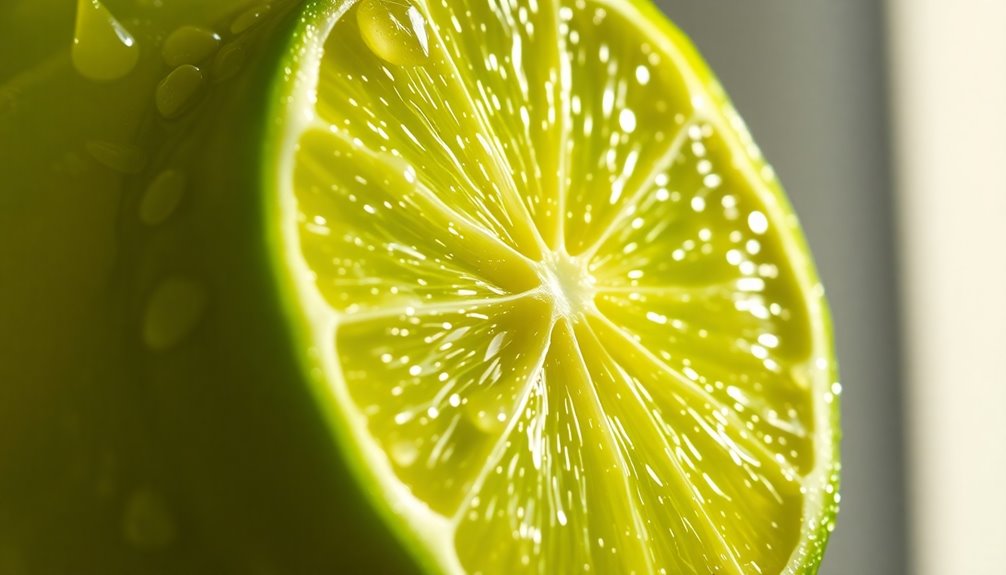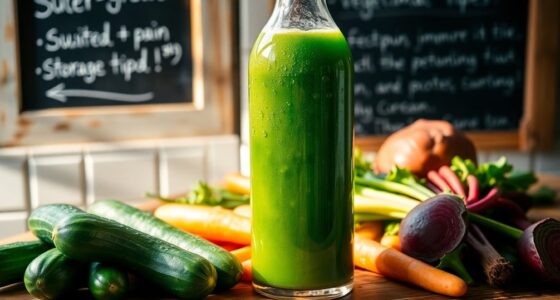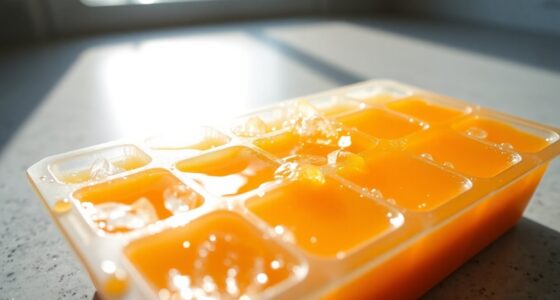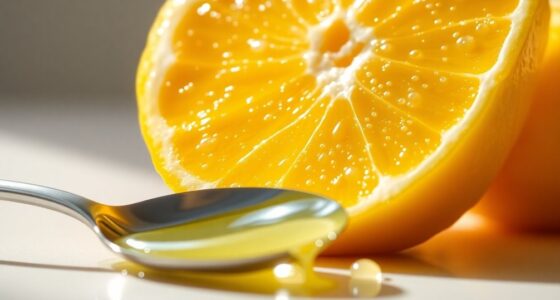A medium lime typically gives you about 2 tablespoons, or 1 ounce, of juice. If you're planning a recipe, keep in mind that you'll need around 8 limes for a full cup of juice. Fresh limes offer a brighter flavor compared to bottled juice, making them a better choice for your dishes. For tips on maximizing your lime juice yield and using it in recipes, keep exploring this topic further!
Key Takeaways
- A medium lime yields about 2 tablespoons (1 ounce) of juice.
- Approximately 8 limes are needed to make a full cup of lime juice.
- A pound of limes typically contains 4 to 5 limes.
- 4 to 5 limes yield about 8 to 10 tablespoons (1/2 to 2/3 cup) of juice.
- Key limes produce a similar amount of juice per lime as regular limes.
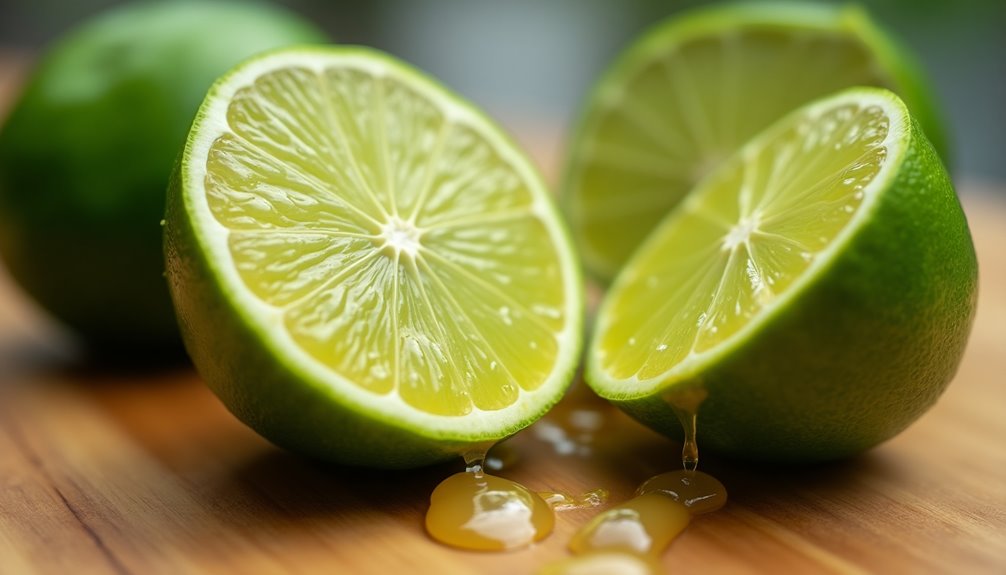
Have you ever wondered how much juice you can expect from a single lime? If you've ever found yourself in the middle of a recipe that calls for fresh lime juice, you might've pondered this very question. Knowing the yield of one lime can save you a trip to the grocery store and help you perfect your culinary creations.
Generally, a medium lime yields about 2 tablespoons, or 1 ounce, of juice. That’s a pretty handy amount when you’re whipping up a refreshing drink or a zesty dish. When planning a recipe that requires lime juice, it’s always useful to know how much juice in a lime you can expect. In addition to the standard medium lime, larger limes may yield up to 3 tablespoons, while smaller ones could provide just 1 tablespoon. This small but significant difference can alter the flavor profile of your dish or beverage, so measuring accurately is key.
When you're preparing a recipe that requires a larger quantity of lime juice—say, a full cup—you'll need to plan accordingly. For that standard cup of fresh lime juice, you'll require around 8 limes. It's easy to underestimate how many limes you'll need, especially if you're not familiar with their juice yield.
If you're working with a pound of limes, you typically get about 4 to 5 limes, which will yield approximately 8 to 10 tablespoons, translating to about 1/2 to 2/3 cup of juice. This means that if you're aiming to create a dish that highlights the vibrant flavor of lime, understanding the amount of juice you can extract from one lime is essential.
Fresh limes are your best bet for juicing. They provide a brighter, more robust flavor compared to bottled alternatives, which can sometimes taste flat or overly sweet. If you want to truly elevate your recipes, fresh lime juice is the way to go.
Whether you're making a classic Key lime pie or a zesty ceviche, the freshness of the juice can make all the difference.
You might also encounter Key limes in your cooking adventures, which are smaller and often have a more intense flavor than their medium-sized counterparts. However, even with Key limes, the average yield remains fairly consistent.
Each lime, regardless of size, typically produces a comparable amount of juice. So, if a recipe calls for a specific number of limes, you can plan on getting roughly the same yield, making it easier to adjust based on what you have on hand.
Frequently Asked Questions
How Much Juice Is in 1 Lime?
When you're cooking or mixing drinks, you often need to know how much juice you can get from a lime.
Typically, one medium lime yields about 2 tablespoons or 1 ounce of juice.
If you're aiming for larger quantities, remember that you'll need around 8 limes to make 1 cup of lime juice.
Can I Substitute Bottled Lime Juice for Fresh Lime Juice?
Did you know that fresh limes can contain up to 2 tablespoons of juice each?
You can substitute bottled lime juice for fresh lime juice, but keep in mind that the flavor won't be as vibrant. If you do swap, aim for 2 to 3 times the amount of bottled juice to match the intensity.
For the best results, choose organic brands, since they often offer better quality than regular bottled options.
How Much Is Juice From 2 Limes?
When you juice two limes, you can expect to get about 4 tablespoons of juice, or roughly 2 ounces.
To ensure you maximize that yield, choose firm, ripe limes. Using a handheld juicer can really help you extract every drop.
If you need a specific amount for a recipe, like 1/4 cup of lime juice, just remember that two limes should do the trick!
Enjoy your fresh lime juice!
How Many Limes for 2 Oz of Juice?
Did you know that one medium lime typically yields about 2 tablespoons of juice?
So, if you need 2 ounces of lime juice for your recipe, you'll want to grab about 2 limes. Each lime generally provides a consistent amount of juice, making it easy to estimate.
Just remember to choose firm, ripe limes to maximize your yield.
With these tips, you'll have the perfect amount of juice for your dish!
Conclusion
In conclusion, when you squeeze one lime, you can expect to get about 2 tablespoons of juice, give or take. It might not sound like much, but that little burst of citrus can transform a dish from bland to spectacular in seconds! So next time you're cooking or mixing drinks, remember that one lime's juice packs a punch that could wake even the sleepiest of taste buds. Don't underestimate the power of that tiny fruit!
Cindy thoroughly researches juicing trends, techniques, and recipes to provide readers with practical advice and inspiration. Her writing style is accessible, engaging, and designed to make complex concepts easy to understand. Cindy’s dedication to promoting the advantages of juicing shines through her work, empowering readers to make positive changes in their lives through the simple act of juicing.

